
1. Vulcanization, Chlorination, Bromination
The silver-plated layer on the LED bracket will generate silver sulfide when exposed to sulfur-containing gas, and it will generate light-sensitive silver halide when exposed to acidic nitrogen-containing chlorine and bromine gases, which will cause the light source to turn black and fail. Sulfur/chlorine/bromination of light sources may occur in every link of production, storage, aging, and use of LED strip light sources and lamps. After the blackening of the light source is diagnosed as sulfur/chlorine/bromination, the customer should choose a specific sulfur removal plan according to the occurrence of sulfur/chlorine/bromination. At present, the sulfur/chlorine/bromine detection items launched by SignliteLED include: sulfur/chlorine/bromine exhaust from lamps (including built-in power supply), sulfur/chlorine/bromine exhaust from lamps (except external power supply), sulfur/chlorine/bromine exhaust from power supply, auxiliary material exhaust Sulfur/chlorine/bromine, sulfur/chlorine/bromine exhaust from packaging workshop, sulfur/chlorine/bromine exhaust from lighting workshop, sulfur/chlorine/bromine exhaust from reflow soldering workshop. Since sulfur/chlorine/bromine-containing gases will permeate into the light source through the gaps in the silica gel or the bracket, SignliteLED has also launched an airtight inspection plan to further assist customers in improving the requirements for incoming light sources.
2. Oxidation
Silver reacts easily with oxygen in high temperature and high humidity environment to form black silver oxide. After SignliteLED diagnoses that the cause of the blackening of the light source is the oxidation of the silver plating layer, it will advise customers to further check the airtightness of the light source and lamps to eliminate the path of moisture penetration.
3. Carbonization
Based on experience, the disadvantages of the six raw materials of the LED strip (chip, bracket, die-bonding glue, bonding wire, phosphor powder, and packaging glue) and the limitations of the three major packaging processes (die-bonding, wire bonding, and glue filling) Process defects may lead to extremely high temperature of the light source, resulting in blackening of part or all of the light source and carbonization of the light source. Unreasonable heat dissipation design of LED lamps, low thermal conductivity of heat dissipation materials, unreasonable power supply design, and too many reflow soldering defects will also cause carbonization of the light source. Therefore, when SignliteLED initially diagnoses that the cause of the blackening of the light source is carbonization, it will advise customers to take the path of LED strip light source or lamp failure analysis, dissect the light source/lamp, and find out the defect or the source of high thermal resistance.
4. Chemical incompatibility
Blackening of LED light sources can also be caused by chemical contamination, which often occurs in sealed luminaires with little or no air movement. When SignliteLED diagnoses that the blackening of the light source is caused by chemical compatibility issues, it will advise customers to conduct chemical incompatibility investigations on the materials used in the lamps to find out materials that are incompatible with the light source. Frequently encountered problems. However, the blackening of the light source is only an appearance. Reasons such as sulfidation, chlorination, bromination, oxidation, carbonization, and chemical incompatibility will all lead to the blackening of the LED light source. Due to the lack of professional testing equipment and personnel, most LED companies usually rely on experience and guesswork when doing blackening failure analysis, lacking scientific testing data. In response to this phenomenon, SignliteLED launched the service of starting the diagnosis of the blackening of the LED strip light source, aiming to help customers quickly, low-cost, and accurately characterize the cause of the blackening of the LED strip light source within 2 days (whether it is sulfuration, chlorination, bromine Oxidation, carbonization, or chemical incompatibility?), at the same time provide customers with further solutions to find out the problem according to the LED strip light source blackening failure analysis road map.




